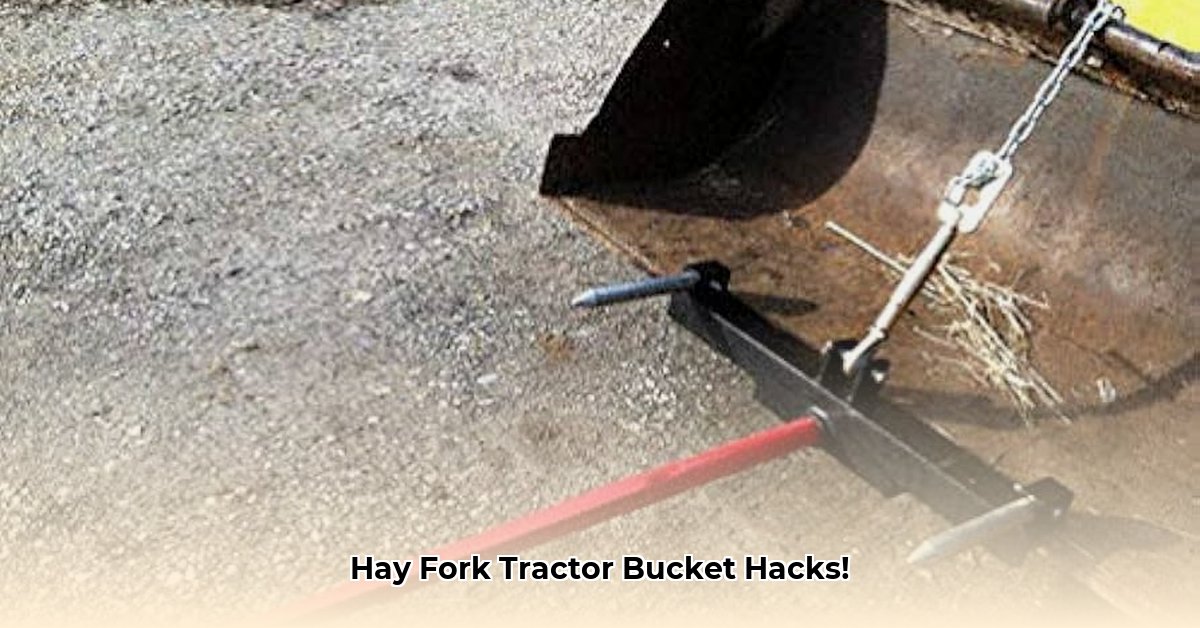
Haying season is demanding, but it doesn't have to be backbreaking. Using a hay fork on your tractor bucket dramatically improves efficiency and promotes sustainable farming practices. This guide provides step-by-step instructions and expert advice to maximize your hay harvesting efforts. Let's get started! For more information on tractor bucket forks, check out this helpful resource: Tractor Bucket Forks.
Selecting the Right Hay Fork
Choosing the right hay fork significantly impacts your operation's efficiency and sustainability. A poorly chosen fork can lead to wasted time, damaged hay, and increased fuel consumption. Consider these factors:
- Tractor Capacity: Ensure the fork's weight capacity doesn't exceed your tractor's lifting limit. Overloading is dangerous and can damage your equipment.
- Hay Type and Bale Size: Dense alfalfa requires sturdier forks than lighter grasses. Larger bales necessitate larger forks with wider tine spacing.
- Tine Spacing: Closer spacing is ideal for smaller bales or loose hay; wider spacing suits larger bales. The correct spacing prevents hay loss and ensures safe lifting.
Don't underestimate the importance of this first step! A well-matched fork translates to smoother operations and significant long-term savings. Have you considered the impact of using the wrong fork on your annual hay yield?
Safe and Efficient Hay Fork Operation: A Step-by-Step Guide
Safety is paramount. Always engage the parking brake before attaching or operating the hay fork. Meticulously inspect all connections for security to prevent accidents. Here's a safe and efficient workflow:
- Secure Attachment: Carefully attach the hay fork to your tractor's quick-attach system, ensuring a firm and stable connection.
- Test Lift: Gently lift a small load to verify proper function and secure attachment before proceeding.
- Grasping the Hay: Approach the hay cautiously, using appropriate tine spacing to securely grasp the bales or loose hay.
- Lifting and Transporting: Lift smoothly, avoiding jerky movements to prevent spills and damage.
- Smooth Detachment: Gently lower the load, then carefully detach the forks.
Following these steps minimizes the risk of accidents and maximizes efficiency. Dr. Emily Carter, Agricultural Engineering Professor at Purdue University, emphasizes, "Proper technique isn't just about speed; it’s about safety and preventing equipment damage."
Optimizing Hay Handling for Maximum Efficiency
Hay handling significantly affects overall efficiency. Strategic planning minimizes wasted time and resources.
- Route Planning: Plan routes to minimize travel time and fuel consumption. Less driving equals lower operating costs.
- Organized Storage: Keep bales organized for easy access and retrieval, reducing search time and labor.
- Bale Spear Integration: Using a bale spear alongside the hay fork further boosts efficiency, especially on uneven terrain.
Did you know that optimized hay handling can reduce labor costs by up to 15%? These seemingly small adjustments add up to substantial savings over time.
Hay Fork Maintenance: An Investment in Longevity
Regular maintenance ensures your hay fork's long-term performance. Neglecting maintenance leads to premature wear and costly repairs.
- Post-Use Inspection: Inspect tines, chains, and hydraulic lines for damage after each use.
- Lubrication: Lubricate moving parts to reduce wear and tear.
- Indoor Storage: Store the forks indoors to protect them from the elements.
"Preventive maintenance is cheaper than reactive repairs," advises John Miller, a veteran farmer from Iowa. "A little time spent on upkeep goes a long way." Investing in maintenance reduces downtime and extends the lifespan of your equipment.
Comparing Hay Fork Options
Various hay forks cater to different needs. Consider the following:
| Feature | Advantages | Disadvantages |
|---|---|---|
| Heavy-Duty Forks | Increased durability, handles heavier loads | Higher initial cost |
| Lightweight Forks | Easier to handle, less strain on tractor | Reduced durability, lower weight capacity |
| Narrow Tine Spacing | Secure handling of smaller bales, minimizes hay loss | Less versatile for larger bales |
| Wide Tine Spacing | Increased versatility for different bale sizes | Potential for increased hay loss with smaller bales |
Choosing the right fork depends on your specific needs and budget. Careful consideration is crucial for a worthwhile investment. How have you optimized your hay fork selection for your specific farming conditions?
Minimizing Hay Spoilage: Sustainable Practices for High-Density Baling
Hay spoilage reduces yields and undermines sustainable practices. Employing efficient pre- and post-baling strategies significantly minimizes these losses.
- Optimal Harvesting Time: Cut hay at its ideal maturity stage, avoiding overripe or underripe hay.
- Moisture Control: Use a moisture meter to ensure optimal moisture content (15-18%) before baling.
- Proper Bale Density: High-density baling is efficient, but excessively dense bales can trap moisture and heat, leading to spoilage.
- Strategic Storage: Choose a well-drained, well-ventilated storage area, and use tarps to protect bales from the elements.
Implement these strategies, and you'll dramatically improve the quality, yield, and overall sustainability of your hay production. Remember, even small steps towards conservation have a substantial cumulative impact overall.